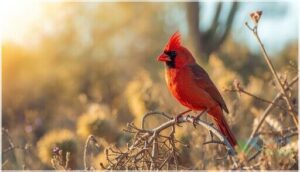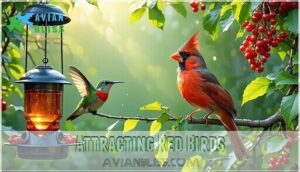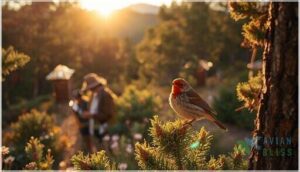This site is supported by our readers. We may earn a commission, at no cost to you, if you purchase through links.

Northern Cardinals thrive in desert washes and riparian areas, especially around Phoenix and Tucson.
Summer Tanagers frequent oak woodlands in sky islands like the Catalina Mountains.
Desert Cardinals, actually Pyrrhuloxias, inhabit thorny desert scrub with their gray bodies and red highlights.
House Finches show variable red coloring on males.
Vermilion Flycatchers flash brilliant red in cottonwood groves.
Peak viewing happens during spring migration and breeding season when males display brightest plumage.
Each species has distinct habitat preferences and identifying features that separate casual sightings from memorable encounters, making it a great time for peak viewing.
Table Of Contents
- Key Takeaways
- Northern Cardinals in Arizona
- Desert Cardinals
- Identifying Red Birds
- Birding Hotspots
- Attracting Red Birds
- Conservation Efforts
- Frequently Asked Questions (FAQs)
- What is the bright red bird in Arizona?
- How rare are red cardinals in Arizona?
- Are there other red birds besides cardinals?
- What are the cardinal like birds in Arizona?
- What is the red bird in Arizona?
- What bird looks like a cardinal in Arizona?
- What is the red bird that is not a cardinal?
- Is it rare to see a Scarlet Tanager?
- What are the nesting habits of red birds?
- How do red birds interact with other species?
- Conclusion
Key Takeaways
- You’ll find Arizona’s most striking red birds in diverse habitats – Northern Cardinals thrive in desert washes and urban areas, while Summer Tanagers prefer oak woodlands in mountain ranges like the Catalinas.
- Peak viewing occurs during spring migration and breeding season when males display their brightest red plumage, making this the optimal time for memorable bird encounters across the state.
- Don’t overlook the Pyrrhuloxia (desert cardinal) – this gray-bodied bird with red highlights inhabits thorny desert scrub and offers a unique alternative to the traditional Northern Cardinal.
- You can attract these red birds to your yard by offering sunflower seeds in tube feeders, providing water sources, and creating dense shrub plantings that serve as both nesting sites and protection from predators.
Northern Cardinals in Arizona
Throughout Arizona’s desert landscapes, Northern Cardinal sightings create memorable moments for bird enthusiasts.
These cardinal birds arizona residents display striking red plumage year-round, with males showcasing brilliant scarlet feathers against black facial masks.
You’ll find these arizona birds in mesquite thickets, urban parks, and riparian areas where dense vegetation provides shelter.
Cardinal Behavior includes ground foraging for seeds and insects, while their clear Vocalizations ring through desert mornings.
Cardinal Adaptations help them thrive in arid conditions, and their Mating Rituals involve males feeding females during courtship.
With proper habitat, their Lifespan reaches 13-15 years, making these red birds arizona treasures worth protecting and observing.
Desert Cardinals
When you’re exploring Arizona’s deserts, you’ll discover that Northern Cardinals aren’t the only "red birds" calling this landscape home.
The striking Pyrrhuloxia, often called the "desert cardinal," shares many territories with its more famous cousin but sports a distinctive grayish body with brilliant red accents on its wings, tail, and crested head.
Physical Characteristics
Desert cardinals showcase striking sexual dimorphism in their red plumage characteristics. Males display vibrant red crests and face masks against gray bodies, while females show subtle reddish accents on brownish-gray plumage.
These red birds arizona species exhibit distinct size comparison features and unique markings that distinguish them from other colorful plumage species.
Key physical traits include:
- Plumage variation: Males bright red, females muted gray-brown with red highlights
- Curved yellow bills: Perfect for cracking desert seeds and tough plant materials
- Prominent crests: Raised when excited or during territorial displays
- Size: 8-9 inches long with sturdy, compact build for desert survival
- Juvenile appearance: Young birds resemble females until first molt develops adult bird characteristics
Habitat and Range
Pyrrhuloxia birds call Arizona’s Sonoran Desert home, thriving in mesquite bosques and desert scrub below 4,500 feet elevation.
These gray-bodied birds with red crests concentrate near water sources and riparian corridors in southern and central Arizona.
| Habitat Feature | Elevation Range | Distribution |
|---|---|---|
| Desert scrub | 1,500-4,500 ft | Southern Arizona |
| Mesquite bosques | 2,000-6,000 ft | Central valleys |
| Riparian corridors | 1,200-4,000 ft | Stream channels |
Their regional distribution follows arizona bird habitats closely tied to water availability. Specialized glands aid in maintaining their fluid balance.
Habitat overlap occurs with Northern Cardinals in riparian zones. Climate impact and drought affect their migratory patterns locally.
Identifying Red Birds
You’ll encounter several red bird species across Arizona’s diverse landscapes, each with distinct identifying features that make field identification straightforward.
Learning to distinguish between cardinals, tanagers, and other red species will enhance your birding experience and help you appreciate the unique characteristics of each bird you spot, which is crucial for a fulfilling birding experience.
Scarlet Tanager
After learning about desert cardinals, let’s talk scarlet tanager. This rare visitor to Arizona stands out among arizona birds and can trip up even seasoned arizona bird identification fans.
Watch for these features:
- Bright red body with jet-black wings and tail
- Thick, hooked bill for hunting insects
- Olive-yellow plumage variation in females and immatures
Spotting a scarlet tanager during arizona bird watching is a real treat! They’re migratory birds, and habitat preferences vary across North America.
Summer Tanager
Summer Tanagers bring a flash of brilliant red to Arizona’s summer birds scene. These medium-sized songbirds arrive during breeding season, with males displaying stunning rose-red plumage that sets them apart from other red birds in Arizona.
Their insect diet focuses heavily on bees and wasps, showcasing unique feeding behaviors. During migration patterns, they frequent riparian woodlands where cottonwoods and sycamores thrive.
Unfortunately, habitat loss threatens these areas. Plumage variation between sexes is striking – females show yellow-olive coloring while males remain uniformly red.
Their breeding habits include building shallow cup nests in horizontal tree forks, typically producing 3-4 eggs per clutch.
| Feature | Male Summer Tanager | Female Summer Tanager |
|---|---|---|
| Body Color | Rose-red throughout | Yellow-olive |
| Bill Shape | Thick, blunt | Thick, blunt |
| Size | 6.7 inches | 6.7 inches |
Birding Hotspots
You’ll find Arizona’s top red bird watching locations across diverse state parks and national forests throughout the region.
These protected areas offer prime habitat where cardinals, tanagers, and other red species thrive year-round or during key migration periods.
State Parks
Arizona’s state parks serve as premier bird sanctuaries for spotting red species.
Catalina State Park and Boyce Thompson Arboretum feature diverse park habitats with accessible hiking trails and observation blinds.
These camping spots offer year-round cardinal and pyrrhuloxia viewing opportunities.
Many parks support conservation impact through citizen science programs, making them ideal destinations for arizona birds identification while contributing to arizona wildlife research efforts.
National Forests
Arizona’s national forests offer exceptional forest habitats for spotting diverse red birds.
These protected areas showcase remarkable bird diversity while facing ongoing conservation challenges. Popular hiking trails provide scenic views and prime birding opportunities for arizona birds identification.
Here are top forest locations for red bird watching:
- Oak Creek Canyon (Coconino National Forest) – Cardinals year-round along riparian zones
- Madera Canyon (Coronado National Forest) – Summer and Scarlet Tanagers during migration
- Verde River corridor (Prescott National Forest) – Vermilion Flycatchers in lower elevations
- Sycamore Canyon – Mixed populations of arizona native birds including Pyrrhuloxia
- Mogollon Rim – Breeding cardinals and tanagers in mixed woodland arizona wildlife habitat
These locations help with bird identification arizona while supporting vital conservation efforts. The Pacific Flyway intersects with some Arizona habitats, making it a vital area for seasonal bird migration.
Attracting Red Birds
You can transform your backyard into a haven for Arizona’s stunning red birds with the right feeders and habitat features.
Creating nesting sites and offering preferred foods will bring cardinals, tanagers, and other colorful species right to your window.
Feeders and Food
Creating an inviting backyard for red birds in Arizona starts with understanding their seed preferences. Cardinals love sunflower seeds while tanagers prefer suet cakes rich in insects.
Offer multiple feeder types including tube feeders for small seeds and platform feeders for larger varieties. Water sources attract Arizona desert birds year-round.
Natural foods like native berries complement artificial feeding. Winter feeding becomes essential when natural food sources decline.
Many bird enthusiasts find bulk seed options economical for attracting cardinals with sunflower seeds.
Nesting Sites
Beyond food, red birds in Arizona need secure nesting sites to raise their young successfully.
Here’s how to create bird-friendly nesting habitats:
- Provide dense shrubs and thickets – Cardinals prefer nest heights of 3-10 feet in thorny bushes that offer nest camouflage from nest predators like snakes and cats
- Plant native trees – Cottonwoods and mesquites support proper nest density while providing nest materials like twigs and bark strips
- Leave natural debris – Small branches, dried grasses, and plant fibers help birds construct sturdy nests in bird habitats in Arizona
- Create layered vegetation – Multiple canopy levels accommodate different bird breeding habits and nesting preferences across red birds in Arizona species
- Maintain water sources nearby – Nesting birds need consistent water access for drinking and nest construction during bird nesting season in desert bird habitats and ecosystems
Consider Arizona nesting shrubs for ideal habitat.
Conservation Efforts
You’ll play a vital role in protecting Arizona’s red bird populations by supporting habitat conservation and participating in citizen science projects.
Urban development and climate change threaten species like the Red-faced Warbler, which breeds almost exclusively in Arizona and New Mexico, making local conservation efforts essential for their survival.
Habitat Loss
Habitat loss threatens Arizona’s red birds through urban sprawl, agriculture effects, and climate impact.
Over 300,000 acres disappeared since 2000, creating fragmentation issues that reduce cardinal territories by 40%.
Drought decreased red bird populations 37% in southeastern Arizona.
Conservation strategies include riparian restoration and native plantings.
Supporting bird conservation efforts helps protect these birds of arizona and their critical bird habitats in Arizona.
Citizen Science Projects
Public involvement strengthens Arizona birds conservation through volunteer opportunities and bird data collection.
Join these monitoring programs to track bird populations and create conservation impact:
- eBird – Submit sightings to build Arizona’s bird database
- Christmas Bird Count – Annual community bird counting event
- FeederWatch – Monitor backyard bird visitors during winter months
- Breeding Bird Survey – Track nesting success in designated routes
Your bird watching efforts provide researchers with critical data for bird research and public engagement initiatives.
These efforts greatly improve conservation data accuracy.
Frequently Asked Questions (FAQs)
What is the bright red bird in Arizona?
Flashing scarlet wings catch your eye—you’re likely spotting Arizona’s Northern Cardinal, the state’s most vibrant red bird. Males display brilliant crimson plumage with distinctive black masks and crests.
How rare are red cardinals in Arizona?
Red cardinals aren’t particularly rare in Arizona. You’ll find Northern Cardinals year-round in the southeast, central, and northwest regions. They’re common in woodlands, gardens, and shrublands throughout these areas.
Are there other red birds besides cardinals?
Yes, you’ll find several striking red birds in Arizona beyond cardinals.
Summer Tanagers are brilliant red, Vermilion Flycatchers flash vibrant crimson, House Finches sport rosy-red heads, and Hepatic Tanagers display reddish-brown plumage throughout the state’s diverse habitats.
What are the cardinal like birds in Arizona?
You’ll find Pyrrhuloxia in Arizona’s desert regions. These cardinal-like birds have gray bodies with red crests, wings, and tails, plus curved yellow bills instead of cardinals’ straight orange beaks.
What is the red bird in Arizona?
Looking through Arizona’s crimson-crowned sky, you’ll spot the Northern Cardinal as your most striking red bird.
Males display brilliant scarlet plumage with black masks, while females show warm browns with red highlights.
What bird looks like a cardinal in Arizona?
You’ll likely spot a Pyrrhuloxia, which shares the cardinal’s distinctive crest and similar size but displays gray plumage with red accents on wings, tail, and face.
What is the red bird that is not a cardinal?
You’ll likely spot a Vermilion Flycatcher, which displays vibrant red plumage on males with grayish-brown females.
Summer Tanagers also show brilliant red coloring in males, while House Finches have rosy-red heads and breasts.
Is it rare to see a Scarlet Tanager?
Spotting a Scarlet Tanager is like finding a ruby in your backyard – exceptionally uncommon in Arizona.
You’ll have better luck during migration seasons when these eastern wanderers occasionally drift westward, creating rare birding treasures.
What are the nesting habits of red birds?
Red birds show diverse nesting habits.
Cardinals build cup nests in dense shrubs, laying 2-5 eggs.
Summer Tanagers nest in tree foliage. Most females incubate eggs for two weeks while males help feed chicks.
How do red birds interact with other species?
While cardinals dominate backyard feeders, summer tanagers compete fiercely for territory. You’ll observe mixed-species flocks where red-winged blackbirds and house finches forage together peacefully, sharing resources and protection from predators.
Conclusion
Researchers found that Arizona hosts over 15 distinct red bird species, making it one of America’s top destinations for red bird enthusiasts.
You’ll discover these stunning red birds in Arizona across diverse habitats from desert washes to mountain forests.
Success depends on timing your visits during spring migration when males display their brightest colors.
Whether you’re seeking Northern Cardinals near water sources or Summer Tanagers in oak woodlands, Arizona’s varied landscapes provide exceptional opportunities for memorable encounters with these brilliant species.











